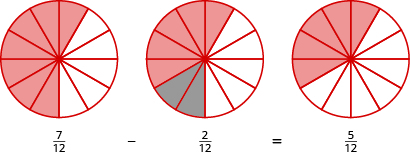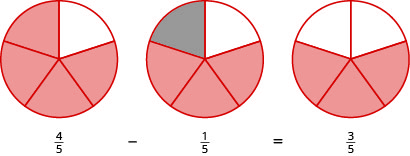Subtracting Fractions With Common Denominators
Learning Outcomes
- Use fraction circles to find the difference between two fractions with like denominators
- Subtract fractions with a like denominator without fraction circles
Model Fraction Subtraction
Subtracting two fractions with common denominators is much like adding fractions. Think of a pizza that was cut into [latex]12[/latex] slices. Suppose five pieces are eaten for dinner. This means that, after dinner, there are seven pieces (or [latex]{\Large\frac{7}{12}}[/latex] of the pizza) left in the box. If Leonardo eats [latex]2[/latex] of these remaining pieces (or [latex]{\Large\frac{2}{12}}[/latex] of the pizza), how much is left? There would be [latex]5[/latex] pieces left (or [latex]{\Large\frac{5}{12}}[/latex] of the pizza).[latex]{\Large\frac{7}{12}}-{\Large\frac{2}{12}}={\Large\frac{5}{12}}[/latex]
Let’s use fraction circles to model the same example, [latex]{\Large\frac{7}{12}}-{\Large\frac{2}{12}}[/latex]. Start with seven [latex]{\Large\frac{1}{12}}[/latex] pieces. Take away two [latex]{\Large\frac{1}{12}}[/latex] pieces. How many twelfths are left? Again, we have five twelfths, [latex]{\Large\frac{5}{12}}[/latex].
Again, we have five twelfths, [latex]{\Large\frac{5}{12}}[/latex].
Example
Use fraction circles to find the difference: [latex]{\Large\frac{4}{5}}-{\Large\frac{1}{5}}[/latex] Solution: Start with four [latex]{\Large\frac{1}{5}}[/latex] pieces. Take away one [latex]{\Large\frac{1}{5}}[/latex] piece. Count how many fifths are left. There are three [latex]{\Large\frac{1}{5}}[/latex] pieces left.
Try It
[ohm_question height="270"]146190[/ohm_question]Subtract Fractions with a Common Denominator
We subtract fractions with a common denominator in much the same way as we add fractions with a common denominator.Fraction Subtraction
If [latex]a,b,\text{ and }c[/latex] are numbers where [latex]c\ne 0[/latex], then[latex]{\Large\frac{a}{c}}-{\Large\frac{b}{c}}={\Large\frac{a-b}{c}}[/latex]
To subtract fractions with a common denominators, we subtract the numerators and place the difference over the common denominator.Example
Find the difference: [latex]{\Large\frac{23}{24}}-{\Large\frac{14}{24}}[/latex]Answer: Solution:
| [latex]{\Large\frac{23}{24}}-{\Large\frac{14}{24}}[/latex] | |
| Subtract the numerators and place the difference over the common denominator. | [latex]{\Large\frac{23 - 14}{24}}[/latex] |
| Simplify the numerator. | [latex]{\Large\frac{9}{24}}[/latex] |
| Simplify the fraction by removing common factors. | [latex]{\Large\frac{3}{8}}[/latex] |
Try It
[ohm_question height="270"]146191[/ohm_question]Example
Find the difference: [latex]{\Large-\frac{10}{7}-\frac{4}{7}}[/latex]Answer: Solution: Remember, the fraction [latex]{\Large-\frac{10}{7}}[/latex] can be written as [latex]{\Large\frac{-10}{7}}[/latex]
| [latex]-\frac{10}{7}-\frac{4}{7}[/latex] | |
| Subtract the numerators. | [latex]{\Large\frac{-10 - 4}{7}}[/latex] |
| Simplify. | [latex]{\Large\frac{-14}{7}}[/latex] |
| Rewrite with the negative sign in front of the fraction. | [latex]{\Large-\frac{14}{7}}[/latex] |
Example
Simplify: [latex]{\Large\frac{3}{8}}+\left(-{\Large\frac{5}{8}}\right)-{\Large\frac{1}{8}}[/latex]Answer: Solution:
| [latex]\Large\frac{3}{8}+\left(-\frac{5}{8}\right)-\frac{1}{8}[/latex] | |
| Combine the numerators over the common denominator. | [latex]{\Large\frac{3+\left(-5\right)-1}{8}}[/latex] |
| Simplify the numerator, working left to right. | [latex]{\Large\frac{-2 - 1}{8}}[/latex] |
| Subtract the terms in the numerator. | [latex]{\Large\frac{-3}{8}}[/latex] |
| Rewrite with the negative sign in front of the fraction. | [latex]{\Large-\frac{3}{8}}[/latex] |
Try It
[ohm_question height="270"]146250[/ohm_question]Licenses & Attributions
CC licensed content, Original
- Question ID: 146190, 146191, 146192, 146250. Authored by: Alyson Day. License: CC BY: Attribution. License terms: IMathAS Community License CC-BY + GPL.
- Revision and Adaptation. Provided by: Lumen Learning License: CC BY: Attribution.
CC licensed content, Shared previously
- Ex: Subtract Fractions with Like Denominators. Authored by: James Sousa (mathispower4u.com). License: CC BY: Attribution.
CC licensed content, Specific attribution
- Prealgebra. Provided by: OpenStax License: CC BY: Attribution. License terms: Download for free at http://cnx.org/contents/[email protected].
